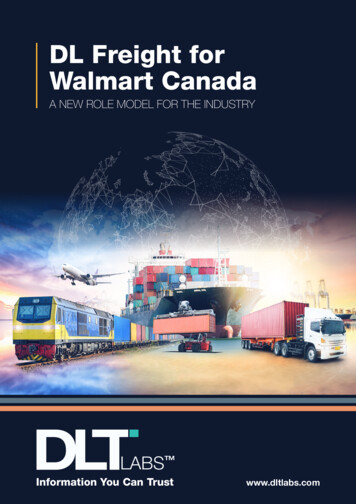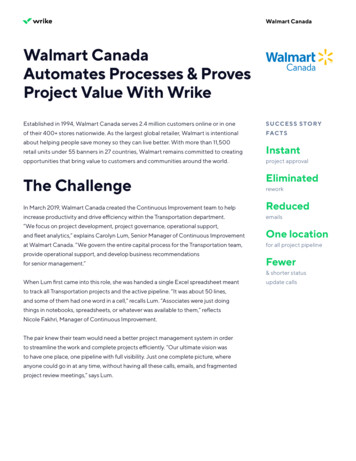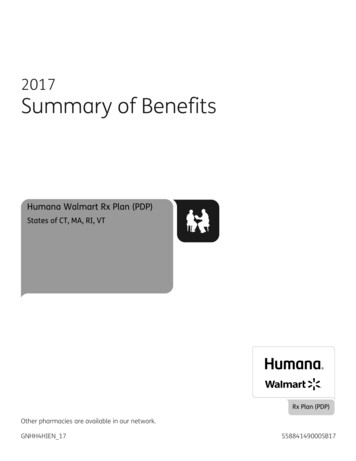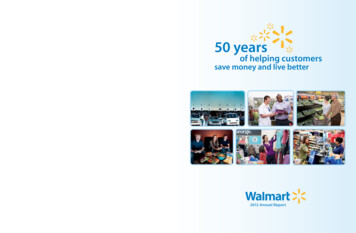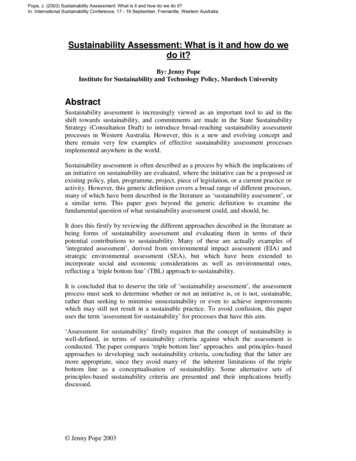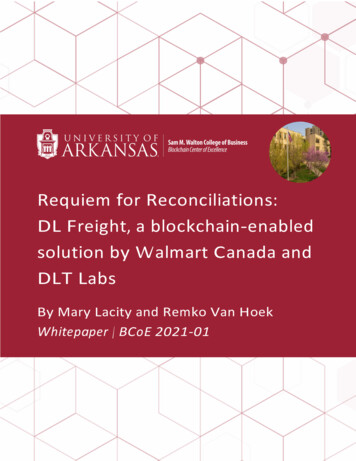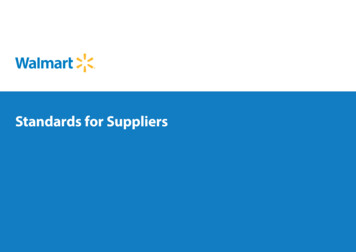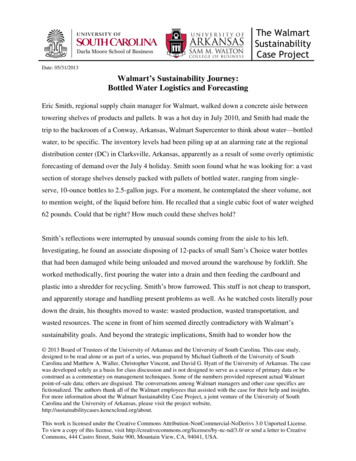
Transcription
The WalmartSustainabilityCase ProjectDate: 05/31/2013Walmart’s Sustainability Journey:Bottled Water Logistics and ForecastingEric Smith, regional supply chain manager for Walmart, walked down a concrete aisle betweentowering shelves of products and pallets. It was a hot day in July 2010, and Smith had made thetrip to the backroom of a Conway, Arkansas, Walmart Supercenter to think about water—bottledwater, to be specific. The inventory levels had been piling up at an alarming rate at the regionaldistribution center (DC) in Clarksville, Arkansas, apparently as a result of some overly optimisticforecasting of demand over the July 4 holiday. Smith soon found what he was looking for: a vastsection of storage shelves densely packed with pallets of bottled water, ranging from singleserve, 10-ounce bottles to 2.5-gallon jugs. For a moment, he contemplated the sheer volume, notto mention weight, of the liquid before him. He recalled that a single cubic foot of water weighed62 pounds. Could that be right? How much could these shelves hold?Smith’s reflections were interrupted by unusual sounds coming from the aisle to his left.Investigating, he found an associate disposing of 12-packs of small Sam’s Choice water bottlesthat had been damaged while being unloaded and moved around the warehouse by forklift. Sheworked methodically, first pouring the water into a drain and then feeding the cardboard andplastic into a shredder for recycling. Smith’s brow furrowed. This stuff is not cheap to transport,and apparently storage and handling present problems as well. As he watched costs literally pourdown the drain, his thoughts moved to waste: wasted production, wasted transportation, andwasted resources. The scene in front of him seemed directly contradictory with Walmart’ssustainability goals. And beyond the strategic implications, Smith had to wonder how the 2013 Board of Trustees of the University of Arkansas and the University of South Carolina. This case study,designed to be read alone or as part of a series, was prepared by Michael Galbreth of the University of SouthCarolina and Matthew A. Waller, Christopher Vincent, and David G. Hyatt of the University of Arkansas. The casewas developed solely as a basis for class discussion and is not designed to serve as a source of primary data or beconstrued as a commentary on management techniques. Some of the numbers provided represent actual Walmartpoint-of-sale data; others are disguised. The conversations among Walmart managers and other case specifics arefictionalized. The authors thank all of the Walmart employees that assisted with the case for their help and insights.For more information about the Walmart Sustainability Case Project, a joint venture of the University of SouthCarolina and the University of Arkansas, please visit the project about.This work is licensed under the Creative Commons Attribution-NonCommercial-NoDerivs 3.0 Unported License.To view a copy of this license, visit http://creativecommons.org/licenses/by-nc-nd/3.0/ or send a letter to CreativeCommons, 444 Castro Street, Suite 900, Mountain View, CA, 94041, USA.
Bottled Waterperpetual inventory system even recorded this reduction in inventory. Was it recorded at all? Itappeared to be time to get smarter about water at Walmart.Bottled WaterWater in a plastic bottle might not be the most exciting product category, but sales of bottledwater have registered nearly continuous growth for more than three decades. The idea of bottlingwater began in Europe in the 1700s, when mineral spring water was bottled and sold for itsreputed healing properties. In the early twentieth century, bottled water in Europe offered a safealternative to unsanitary tap water in many areas. Bottled water entered the U.S. market muchlater; sanitization of public water had been available there since early in the twentieth century.But consumption of bottled water in the United States saw rapid increases in the 1990s and2000s, rising from 9.8 gallons per person in 1992i to 27.6 gallons per person in 2009.ii Overall,consumption of bottled water grew a thousand-fold between 1984 and 2005.iii The drivers of thisincrease were numerous and varied: an aging municipal water infrastructure; a perception thatbottled water was safer and tasted better than tap water;iv and greater mobility that requiredconvenient, portable water delivery methods. Another important growth driver was the increasedfocus on healthy diet and lifestyle choices, in which proper hydration and avoidance of sugarydrinks both play important roles. People who consume bottled water regularly are twice as likelyto cite health concerns as a factor in their beverage choices than those who do not. Furthermore,the increase in bottled water consumption was accompanied by a greater share of householdsusing water filters at home.Overall, water made up 41% of the beverages Americans consume, and bottled water constitutednearly one-third of total water consumption.v Studies showed that bottled water drinkers weredisproportionately from ethnic minorities and had higher-than-average levels of education.Furthermore, though bottled water often was compared to tap water, only 30% of its consumerssaid they would drink tap water if bottled water were not available; the others would choosesome other bottled beverage. Thus the market that featured bottled water also includedcarbonated soft drinks, sports drinks, juices, coffee, milk, and beer. In this category, bottledwater had gained ground against all its competitors, especially soft drinks. Between 2000 and2009, bottled water’s market share increased from 9% to 14.5%, while soft drinks fell from 30%to 24%. During the economic downturn that began in 2008, sales of nearly all beveragesdecreased, but bottled water sales decreased less than those of all other beverage categories.Page 2
Bottled WaterBottled water sold in many sizes and formats, bottled in both glass and various types of plasticbottles, but 70% of water sold in the United States used a “single-serve” format and came inpolyethylene terephthalate (PET) plastic bottles. Bottled water also can be classified into severalsubcategories, such as carbonated, mineral, artesian, spring, purified, and deionized. None ofthese varieties include flavorings as such, though added minerals can enhance flavor. Watercomes from various sources or goes through several processes, depending on its labeling. Themost common label is pure or purified water. Purified water may be from any acceptable source,including springs or municipal sources, but the dissolved solids must be removed from it usingdistillation or reverse osmosis. Spring water comes from underground and rises to the surfacewithout active extraction. Mineral water may be from any source but contains a minimum levelof minerals. Regardless of the source, all bottled water must be sanitized and filtered.Recent trends indicated consumers prefer packages of multiple, smaller bottles rather than single,larger bottles, so the fastest growing product category is 12- and 24-packs of single-serve, 10fluid ounce (237 ml) bottles. Walmart’s private label water brands, Sam’s Choice and GreatValue, sold in such packs, were bottled in five locations in North America (Quebec, Florida,Texas, and two West Virginia sites), and competed primarily on price.Walmart and Sustainability“We didn’t get where we are today by being like everyone else and driving the middle of theroad,” said Lee Scott, CEO of Walmart, in 2005. “We became Walmart by being different,radically different.”vi The radical difference Scott proposed that day was sustainabilityleadership, committing the company to be supplied by 100% renewable energy, to produce zerowaste, and to sell products that not only sustained communities but also protected theenvironment. He gave no timelines for achieving those goals, and admitted he didn’t knowexactly how to achieve them. But the environment was being degraded by human activity, whichwas hurting people—“Katrina in slow motion,” Scott called it, referring to the devastating 2005hurricane—and people involved in business had an opportunity and the responsibility toeliminate this negative impact.In retrospect, the speech and emphasis on sustainability came to be regarded as a significantchange for Walmart, yet Scott couched it as a continuation of Walmart’s longstanding principleof finding business opportunities in unlikely places. At Walmart’s founding in 1962, founderPage 3
Bottled WaterSam Walton chose to place stores in small towns in the Midwestern and southern United States,even as most retail enterprises were focusing on large cities. Walmart challenged theconventional wisdom by establishing a highly centralized system of store-level planning, and by1987, it had completed the installation of the largest private satellite network in the world,connecting every store with its home offices in Bentonville, Arkansas.vii The company alsochallenged a traditional model of outsourced transportation services, establishing its owntrucking fleet in the late 1970s in response to the high rates charged by trucking companies todeliver to stores in small towns.viiiWalton’s innovative thinking resulted in explosive growth for his company. By 1996 Walmarthad a presence in all 50 U.S. states and five countries, including China. In 1999, with 1.1 millionemployees, Walmart became the world’s largest private employer. Scott considered Walmart’ssize both a challenge and an opportunity: “We are in uncharted territory,” he noted. “If we werea country, we would be the 20th largest in world. Due to our size and scope, we are uniquelypositioned to have great success and impact in the world, perhaps like no company before us.”In other contexts, Scott made the case that sustainability was not just another task on a to-do listbut rather a lens through which to see the world and business.ix This led the company to rethinkthe role of consumers in achieving sustainability. For instance, Walmart actively influencedcustomers’ light bulb purchasing decisions, directing them toward more expensive compactfluorescent bulbs and away from cheaper, energy-intensive incandescent bulbs.x Sustainabilitywas not a philanthropic add-on but a new way of doing business that could also ensure additionalprofits for the company. For example, waste is both an economic loss and an environmentalhazard, and thus Walmart would focus on waste reduction strategies. In particular, Scottemphasized supply chain waste and pollution:If there is waste or pollution, someone along the line pays for it. For example, ifour trucks are inefficient from a fuel standpoint, we’ll pay for that at the dieselpump. If the dumpsters behind our stores fill up with trash, you can be assuredthat we paid someone to send that trash to us, and we will pay someone to take itaway. xiSustainability and Bottled WaterWhen The Wall Street Journal asked Lee Scott where to draw a line—sell a product with a highenvironmental cost or not offer it—he had a ready answer: “If the customer wants bottled water,Page 4
Bottled Waterwe are going to sell bottled water. But even if you're going to sell bottled water, you can sell itand have less of a negative impact.” And indeed, the negative impact of bottled water on theenvironment has long been the subject of active discussions among business leaders andenvironmentalists. A 2007 Fast Company article brought the issue to the forefront, framing thedecision to drink bottled water as one with deep ethical implications. For instance, Fiji Waterproduced more than a million bottles of water a day, yet more than half the people on the islandof Fiji did not have reliable, safe drinking water. xii Water bottlers acted quickly to defendthemselves and establish their sustainability credentials. Still, consumers and watchdog groupsremained skeptical. One group, commenting on the controversial Fiji Water product (bottled onthe remote Pacific island and shipped to locations worldwide), asserted:The fact that a product that comes packaged in plastic and is shipped thousands ofmiles from its source of origin could claim the mantle of sustainability is dubiousat best . While we appreciate Fiji Water’s attempt to mitigate the negativeenvironmental impacts of their water operation, the fact remains that the onlytruly sustainable water is the kind that requires no fancy packaging or clevermarketing gimmicks: tap water.xiiiThe quality of bottled water was also questioned, and sometimes even bottled waterrepresentatives were unable to distinguish their products from competitors.xiv A market-basedstudy conducted by an advocacy NGO, Environmental Working Group, indicated that bottledwater contained contaminants at levels no different than routinely found in tap water, noting,Several Sam's Choice samples purchased in California exceeded legal limits forbottled water contaminants in that state. Cancer-causing contaminants in bottledwater purchased in 5 states (North Carolina, California, Virginia, Delaware andMaryland) and the District of Columbia substantially exceeded the voluntarystandards established by the bottled water industry. xvIn terms of packaging, though PET plastics are highly recyclable and can be converted intoproducts like carpeting, fleece clothing, and playground equipment, as well as new containersand bottles, in 2008 only about 13% of plastic bottles ended up in the U.S. recycling stream.Approximately 2 million tons of water bottles instead moved to landfills.xvi Not only would theseplastic bottles take centuries to decompose, but they cannot be incinerated, because burning themreleases toxic chlorine gas into the atmosphere and produces ash containing heavy metals.The NRDC also estimated greenhouse effects related to transportation: In 2006, the 18 milliongallons of bottled water shipped from Fiji to California produced about 2,500 tons of CO2.xviiAccording to a 2007 resolution passed by the U.S. Conference of Mayors, plastic water bottlesPage 5
Bottled Waterproduced for U.S. consumption require 1.5 million barrels of oil per year, which might otherwisepower 250,000 homes or fuel 100,000 cars for a year.xviiiEven as these debates raged, consumer demand for bottled water remained and, as Lee Scottacknowledged, was unlikely to dissipate anytime soon. Rather, the consensus view suggestedthat bottled water would continue to steal market share from other beverages. For Eric Smith,this market status meant that improving Walmart’s bottled water inventories was critical. Theproblem was clear in his mind: Forecasting bottled water demand was simply not good enough,and an investment in improving its forecasting could pay huge dividends for Walmart, bothfinancially and environmentally.Thus when Smith returned to his office later that day, he immediately called Shirley Thomas,director of merchandise replenishment, to ask if they could form a team to assess and improveWalmart’s bottled water forecasting process. Thomas agreed that the waste associated withbottled water was out of line with the company’s sustainability goals, but she was skeptical thatimproved forecasting was the solution. Considering Smith’s strong arguments though, she agreedto help him with the project.Forecasting Bottled Water SalesThe very next day, Smith got started by talking with store and DC managers about theirexperiences with bottled water inventories. Because most sales involved single-serve containers(or multi-packs of single-serve containers), he decided to focus on such products. As he hadanticipated, most of the conversations revolved around problems of excess inventories on the onehand but stockouts on the other, especially around special events such as July 4 or major sportingevents. Year after year, demand during these special occasions got dramatically overestimated orunderestimated. The result was a quantity of bottles on hand that was either far in excess of whatwas needed or not nearly enough. Although bottled water has a long shelf life and is unlikely toexpire, excess bottles tie up capital, occupy valuable storage space, and offer the potential fordamage as they wait to work through excess supply. The sound of water from damaged bottlesbeing poured down the drain still rang in Smith’s ears.Of course, underestimating demand had significant consequences too. For many shoppers, theappeal of Walmart is its offer of a one-stop shop, with a wide array of products: groceries,Page 6
Bottled Watergeneral merchandise, apparel, pharmacy, and so on. Walmart shoppers thus expect products to beon the shelves. Stockouts at the store level might be resolved through interstore transshipmentsto address the shortfall, but this process is highly inefficient. Replacement products also might becoming on the next truck headed for the store from the DC, but this delivery might not occur forseveral days—or more, if the truck did not have any excess space to load the water. From asustainability standpoint, stockouts also waste customers’ fuel and time, because they must travelto another store to complete their purchases. Inventory mistakes, whether they are excess stockor shortages, thus are costly in various ways.One of Smith’s bottled water conversations with Rudy Valendorf, the Director of MerchandiseReplenishment, was particularly insightful, so it is reproduced at length here:VALENDORF: I’m concerned that we’re throwing ourselves at a brick wall. Bottledwater is very costly to move, in terms of money and energy use, not to mentionpollution from bottle production. Besides, it may not be any better for consumersthan plain tap water. Why are we trying to improve the sustainability of thesupply chain of a product if the product is fundamentally unsustainable? It seemsdisingenuous.SMITH: If the bottled water were being substituted for tap water at home, then Iwould agree with you. However, much of it is being purchased as a substitute forother drinks, including colas and even beer, in some cases. You could argue thatproviding bottled water as an alternative is socially responsible. Instead ofpurchasing a bottle of orange soda, some people are purchasing a bottle of water.If our customers wanted tap water they would get it at home; hey, they could evenget it from the faucets in our bathrooms at no cost to them!VALENDORF: But can we really say that one product is sustainable just because itis not as bad as another? The transportation and demand challenges with waterexist in soft drinks, too. Besides, bottled water already costs the consumer lessthan bottled soft drinks. As things lie, there is already an incentive for theconsumer to buy bottled water over other alternatives because it costs less and ismore healthful than are soft drinks, but the environmental costs in terms of energyand resource consumption and the challenges related to waste are the same.SMITH: My point exactly! Both are fast-moving consumer goods with similardemand patterns and a similar supply chain, but one costs less and is better for theconsumer than the other. They both have an environmental cost, and that cost forwater is being exacerbated by our distribution. So we have an obligation toimprove the bottled water supply chain because it is the best alternative, andbecause small improvements can make a big difference, in terms of our costs aswell as our environmental impact.VALENDORF: Sure. But I still have my doubts. Besides, I’m sure that consumeradvocacy and environmental groups are going to start talking aboutPage 7
Bottled Water“greenwashing,” saying that we’re just painting a sustainability façade on anunsustainable product.SMITH: First of all, we’re not planning on changing the labeling or advertising, sowe’re not trying to convince people that drinking bottled water is anenvironmentally friendly activity. We’re just trying to make this product friendlierto the environment. The thing is that we aren’t going to stop people from buyingbottled water. If we stopped selling bottled water altogether, they would eitherbuy a less healthy alternative from us or they would go to a competitor to get it.We’re a big company, and we can influence the market but we can’t fight it.We’ve got to find a way to make what people are buying more sustainable. Theway I see it we can either try to convince people to buy something else, or we canfind ways to make the supply chain for what they are already buying moresustainable. Convincing people to buy something else is tricky. We could end upspending a lot of time, energy, and money and have it fail. On the other hand wealready know there are significant opportunities in the supply chain. I think that’swhere the best opportunity is.VALENDORF: Alright. I’ll buy it. Where do you think we should start?SMITH: I think there are two ways to approach this. One would be to fine-tune thesupply, to improve forecasting and distribution. The other would be to look athow the supply chain could be restructured to make it more flexible or reduceoverall transportation costs.VALENDORF: I think that to make real improvements in the sustainability ofbottled water, we have to design a better supply chain. There has to be a moreefficient form of storing and delivering all these bottles.SMITH: It would be great if you were right! Personally, I prefer to scratch where ititches. The excessive inventory starts when forecasts higher than actual demand.Why don’t we split up and you can look into our possibilities in re-designing theproduct supply chain and I’ll see what we can do about improving ourforecasting?VALENDORF: Sounds like a plan!Chasing the BottleValendorf was serious, and so he set out to become an expert in the bottled water supply chain.As he learned more, he began to note various inefficiencies that might yield opportunities forimprovement. In terms of consumer products, bottled water is simple to produce. It begins beforethe bottle, with a “preform.” Preforms consist of the PET plastic for a bottle, condensed into asmall capsule. Single-serve preforms and bottles, which average about 9 grams each, get shippedto bottling facilities, where they are “blown” or expanded using machines that blow hot air intothe perform, forcing it to take to the shape of a mold.Page 8
Bottled WaterSam’s Choice and Great Value water was purified, bottled, and packaged at five locations in theeastern and south-central United States, then shipped by truck to DCs. As a product, bottledwater was a transportation challenge: Water is dense, so trucks reach their maximum payload(“weigh out”) well before filling all the volume of space in the truck (“cube out”). Afterexpansion, a 10 fl. oz. bottle weighs approximately 246 grams (8.7 oz.), and a 12-pack weighs3,450 grams (7.6 lbs.). Depending on its configuration, a pallet of 12-packs of 10 oz. waterbottles would weigh between 607.5 kg (1,338 lbs.) and 752.4 kg (1,657 lbs.), and they cannot bestacked without crushing the plastic bottles. Thus, dry vans weigh out with 18 pallets, whichwould leave room (but not weight capacity) for 12 more pallets. In other words, for every fivetrucks transporting bottled water, Walmart was transporting the equivalent of two empty trucks.Then, from the DCs, bottled water moved in mixed product trucks to stores. After consumption,most bottles wound up in landfills.The simplest opportunity Valendorf noticed for improving the efficiency of the bottled waterdistribution was readjusting the pallet configuration. He began to play around with variousconfigurations of 12-packs on the pallet (Exhibit 1). In some configurations, the bottles hungover the edge, which would likely lead to waste through damage, though Valendorf was unsurehow much. As he developed different configurations, Valendorf also found ways to approach thetrucks’ weight capacity using configurations that did not require any products to hang over theedge of the pallet. When he calculated the number of bottles per load though, he discovered thatthe current configuration held 71,280 bottles, and his new idea would increase that number to72,900—an improvement of only about 2.2%. Although any improvement was welcome, 2.2%was not the earth-shattering change he hoped to achieve.He considered some more. Perhaps the purified water could be bottled in the DC; it could comefrom any source, including municipal tap water. He looked into the costs: If Walmart startedpurifying and bottling tap water at each DC; it would need to purchase machinery to blow thepreforms, purify the water, and fill the bottles (Exhibit 2). His calculations led Valendorf toconclude that this reorganization of the supply chain was the best choice—maybe not for all thewater categories perhaps, but certainly for simple purified water. Excited, he took his idea toSmith: “This way we could limit the negative impacts of the forecasting variations, by taking astep out of the supply chain. We would have a 36% reduction in transportation miles. This is amuch more environmentally friendly supply chain.”Page 9
Bottled WaterBut Smith was unsure. “Well,” he worried:We would eliminate transportation to the DC for that SKU, but what about theunintended consequences? If we take our highest volume product away from ourbottlers, how will they react? How will it affect the efficiency of the otherproducts? How will it affect our forecasting accuracy of those products? I thinkit’s a good system for eliminating transportation waste, but I’m not sure that itwon’t hurt the bottom line overall. We should at least see what the breakevenpoint would be on all that equipment investment that would be required. Andwhile I think that the new pallet configuration is good, remember that wecurrently use CHEP pallets, which are standardized and recycled through thesupply chain. If we make customized pallets, the total system might be lessefficient.“You raise some good points,” said Valendorf. “Sounds like we need to sit down and considerthe impact of these potential changes more carefully. What have you found on the forecastingside?”ForecastingSmith knew that Walmart had a powerful tool to improve its forecasting: its wealth of point-ofsale (POS) data. He could use these data to improve forecasting for bottled water, but whereshould he begin? With so many forecasting methodologies out there, which would make themost sense in this case? Should forecasting be done at the store level and then rolled up to theDCs? Or should it be done at the DC and then somehow allocated to the stores? One thing wasclear though: If he could make even a small improvement in this area, the implications forWalmart, both financial and environmental, would be dramatic.Store and DC replenishment both require forecasts. Most replenishment systems use time-seriesforecasting methods, which assume an underlying demand pattern. The goal of time-seriesmethods is to see through any noise (e.g., random fluctuations in sales) to determine theunderlying pattern, which should include trends and/or seasonality in demand. In discussionswith Shirley Thomas, Smith considered the various ways to approach forecasting models. Forexample, should the model would be top-down or bottom-up? “A top-down model looks at thetotal demand for all the stores or DCs in the account in consideration and uses that forecast todevelop an order, then breaks that demand up into its parts for shipping,” Thomas explained. “Abottom-up model estimates demand for each destination and sums all those individual demandsto build a forecast for production.” “But, which one is best?” Smith asked.Page 10
Bottled WaterTHOMAS: It depends in part on bullwhip. The bullwhip effect describes howfluctuations in demand are amplified as you move upstream in the supply chain.Moderate ups and downs in consumer demand are slightly exaggerated in storeorders, which are further exaggerated in DC orders.SMITH: Aha! Then our problem is that the bullwhip is cracking every holiday inthe stores, and that’s generating some serious waste in the supply chain.THOMAS: Exactly. But remember not every aspect of the bullwhip effect israndom or even faulty. Orders are placed to maximize transportation efficiency orin accordance with other constraints. So sometimes the variation is generatedintentionally at the store or DC level, which means that if you only pay attentionto POS data you could be missing meaningful variation. But the rules about POSversus orders data and top-down and bottom-up forecasts are only generalguidelines, and specific products can act differently.SMITH: How so?THOMAS: For instance, products with a high rate of sale usually are appropriatefor POS-based forecasting. However, if a product has a high bullwhip effect,POS-based forecasts decrease in accuracy. Also, if the product moves through alot of non-turn volume, such as through special displays or promotions, thatdecreases the accuracy of POS-based forecasts. And if a product has seasonaldemand, it further confounds short-term forecasts based on POS data.SMITH: But that just begs more questions! In water, we have a fast-movingconsumer good, so it should be right for bottom-up POS-data forecasting. But itmay have some bullwhip effect, I know it has a lot of non-turn volume, and Iknow it’s seasonal, though I’m not sure to what extent.THOMAS: Well, I never said forecasting was going to be easy. But I think we canget a handle on this issue if we dive into the POS data we have. It will help usdefine all those parameters. But we need to keep in mind that our problem is notjust mathematical. Psychology and human error are involved, and whateversolutions we find, we’ll have to be able to sell them to the store and DC managers.SMITH: Time-series methods are easy to automate and easy to understand, and thatis why they are used. Certainly bottled water has trend and seasonal components.But we also know that there are other factors that cause changes in demand forbottled water, su
construed as a commentary on management techniques. Some of the numbers provided represent actual Walmart point-of-sale data; others are disguised. The conversations among Walmart managers and other case specifics are fictionalized. The authors thank all of the Walmart employees that assisted with the case for their help and insights.



